





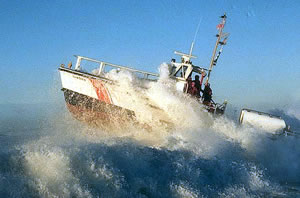 The 44-foot motor lifeboat is a unique craft in the overall development of American coastal lifeboats. A strong challenger of the Pacific Northwest’s trying conditions, the "44" has been used successfully around the nation and has had a worldwide influence on search and rescue craft. In the development of the 44-footer we see a prime example of a vessel being designed for very specific conditions, translating design concepts of seaworthiness, ease of handling, speed, weight, draft, strength and capacity into a much-loved boat that Coast Guard crews speak of in almost reverent tones. Just how did this remarkable craft come to be?
The 44-foot motor lifeboat is a unique craft in the overall development of American coastal lifeboats. A strong challenger of the Pacific Northwest’s trying conditions, the "44" has been used successfully around the nation and has had a worldwide influence on search and rescue craft. In the development of the 44-footer we see a prime example of a vessel being designed for very specific conditions, translating design concepts of seaworthiness, ease of handling, speed, weight, draft, strength and capacity into a much-loved boat that Coast Guard crews speak of in almost reverent tones. Just how did this remarkable craft come to be?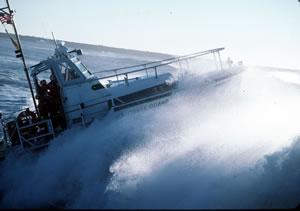 In 1873, the newly reorganized U.S. Lifesaving Service purchased a 30-foot self-righting, self-bailing, pulling and sailing lifeboat from the RNLI, which had spent many years developing a successful lifeboat. Adopting the RNLI’s design with some modifications, the result was a new American lifeboat, 26 feet 8 inches in length. By the late 1880s, the standard American pulling and sailing lifeboat had grown to 34 feet, and in 1899 one of these larger boats was modified to accommodate a gasoline motor. Over the next eight years, significant improvements were made in both motors and lifeboat design. By 1907, these features were combined in the first class of American lifeboats designed from the keel up as motor lifeboats.
In 1873, the newly reorganized U.S. Lifesaving Service purchased a 30-foot self-righting, self-bailing, pulling and sailing lifeboat from the RNLI, which had spent many years developing a successful lifeboat. Adopting the RNLI’s design with some modifications, the result was a new American lifeboat, 26 feet 8 inches in length. By the late 1880s, the standard American pulling and sailing lifeboat had grown to 34 feet, and in 1899 one of these larger boats was modified to accommodate a gasoline motor. Over the next eight years, significant improvements were made in both motors and lifeboat design. By 1907, these features were combined in the first class of American lifeboats designed from the keel up as motor lifeboats.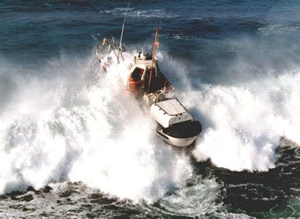 In that year, design development began for a self-righting, self-bailing, steel hull motor lifeboat 40 feet in overall length. This breakthrough boat (numbered CG-40300) was built in 1940 at the Coast Guard Yard in Curtis Bay, Maryland. Instead of the traditional double-ender hull, the CB-40300 had a slightly squared stern, but her hull remained a traditional round-bottom displacement hull. Fitted with a 120 HP Sterling Petrel gasoline engine, she made 10.36 statue miles per hour on her trial runs— only about a mile per hour faster than the Type TRS of 1937. The CG-40300 was, in effect, a traditional but slightly larger and faster boat than the 36-footers, and built of steel instead of wood. It was a modest step forward, although not popular with most lifeboat crews who still preferred the wooden hulls.
In that year, design development began for a self-righting, self-bailing, steel hull motor lifeboat 40 feet in overall length. This breakthrough boat (numbered CG-40300) was built in 1940 at the Coast Guard Yard in Curtis Bay, Maryland. Instead of the traditional double-ender hull, the CB-40300 had a slightly squared stern, but her hull remained a traditional round-bottom displacement hull. Fitted with a 120 HP Sterling Petrel gasoline engine, she made 10.36 statue miles per hour on her trial runs— only about a mile per hour faster than the Type TRS of 1937. The CG-40300 was, in effect, a traditional but slightly larger and faster boat than the 36-footers, and built of steel instead of wood. It was a modest step forward, although not popular with most lifeboat crews who still preferred the wooden hulls.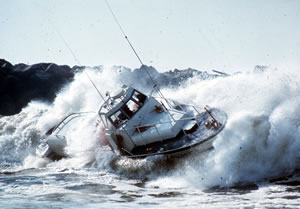 The new motor lifeboat should be self-righting and self-bailing, and able to operate successfully in coastal waters under unusually severe weather and sea conditions. It should be able to negotiate large breaking seas and run into large seas without excessive pounding. It should have increased power and speed, with a full-speed range of 150 miles, and twin screw propulsion to provide greater reliability and improved handling. Improved rescue and towing capability, protected accommodation for survivors and crew, and more efficient, safer working areas were also called for. Structurally, the hull should be of welded Corten steel for greater strength and less corrosion, and it should be designed to withstand icebreaking and accidental groundings, as well as the hard use of working in severe weather, heavy seas and surf.
The new motor lifeboat should be self-righting and self-bailing, and able to operate successfully in coastal waters under unusually severe weather and sea conditions. It should be able to negotiate large breaking seas and run into large seas without excessive pounding. It should have increased power and speed, with a full-speed range of 150 miles, and twin screw propulsion to provide greater reliability and improved handling. Improved rescue and towing capability, protected accommodation for survivors and crew, and more efficient, safer working areas were also called for. Structurally, the hull should be of welded Corten steel for greater strength and less corrosion, and it should be designed to withstand icebreaking and accidental groundings, as well as the hard use of working in severe weather, heavy seas and surf. While responding to a search and rescue mission out of Cape Disappointment on July 29, 1996, the CG-44300 experienced a serious engine breakdown and was withdrawn from service. Although the boat itself was still in excellent condition, the cost of repairing or replacing the damaged engine could not be justified. By then the 44-foot motor lifeboats were beginning to be replaced by the new 47-foot MLBs. After surveying, the boat, the Coast Guard turned her over to the Columbia River Maritime Museum, where she has joined an outstanding collection of U.S. Coast Guard rescue craft.
While responding to a search and rescue mission out of Cape Disappointment on July 29, 1996, the CG-44300 experienced a serious engine breakdown and was withdrawn from service. Although the boat itself was still in excellent condition, the cost of repairing or replacing the damaged engine could not be justified. By then the 44-foot motor lifeboats were beginning to be replaced by the new 47-foot MLBs. After surveying, the boat, the Coast Guard turned her over to the Columbia River Maritime Museum, where she has joined an outstanding collection of U.S. Coast Guard rescue craft.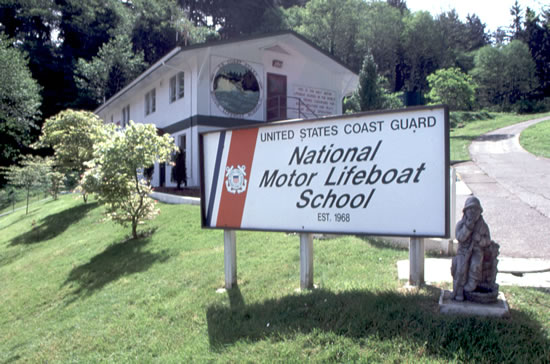

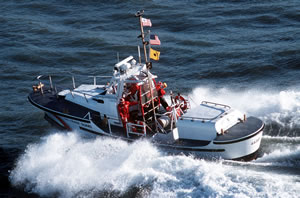 It’s usually hard for me to wake up at 5:30 in the morning. But not on this day—I was heading out to observe 44-foot motor lifeboats (MLB) training on the Columbia River Bar. I was going out there: on the bar, going through the surf, getting a taste of what it would be like to work on an MLB. My vantage point would be from CG-47213, a 47-footer.
It’s usually hard for me to wake up at 5:30 in the morning. But not on this day—I was heading out to observe 44-foot motor lifeboats (MLB) training on the Columbia River Bar. I was going out there: on the bar, going through the surf, getting a taste of what it would be like to work on an MLB. My vantage point would be from CG-47213, a 47-footer. 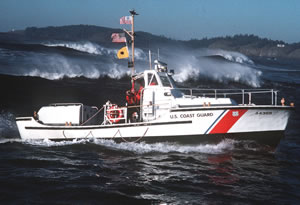 We were ready to go. One of the coxswains loaned me his gloves, and for that I was very grateful. I strapped myself in and evaluated my surroundings. I quickly realized that I had better not get seasick; it would be almost impossible for me to get to the side of the boat. I was instructed to keep my knees bent, eyes open, and to hold on!
We were ready to go. One of the coxswains loaned me his gloves, and for that I was very grateful. I strapped myself in and evaluated my surroundings. I quickly realized that I had better not get seasick; it would be almost impossible for me to get to the side of the boat. I was instructed to keep my knees bent, eyes open, and to hold on!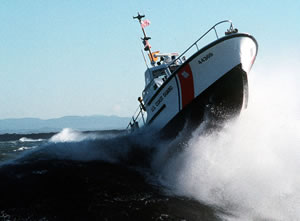 The second drill was to run the boat out toward sea, then turn around and come back. The trick is turning around without getting broadsided by a wave, and returning without having a wave break over the stern. The 47213 MLB is fast enough, with a maximum speed of 25 knots (29 miles/hour). to run at the same speed as the waves. Once the coxswain finds a break in the waves, he can ride that break all the way in. The 44-foot MLB's maximum speed is only 14 knots (16 miles/hour). It is common for the waves to be moving faster than the 44-foot MLB, forcing the her to turn around and square up to the surf until they find another break.
The second drill was to run the boat out toward sea, then turn around and come back. The trick is turning around without getting broadsided by a wave, and returning without having a wave break over the stern. The 47213 MLB is fast enough, with a maximum speed of 25 knots (29 miles/hour). to run at the same speed as the waves. Once the coxswain finds a break in the waves, he can ride that break all the way in. The 44-foot MLB's maximum speed is only 14 knots (16 miles/hour). It is common for the waves to be moving faster than the 44-foot MLB, forcing the her to turn around and square up to the surf until they find another break.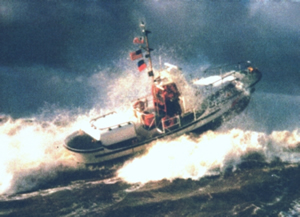 17 Mar 80: Caved in the FWD turtle after minutes worth of breaker drills. Damage appeared to be due to structural weakness and not the size of the breaker. I’d sure be tired, too, after 19 years of back-breaking work, being rolled, pitch poled, run aground on rocks, bounced off jettys, run on the beach, cussed at, and last of all being needle gunned to death.
17 Mar 80: Caved in the FWD turtle after minutes worth of breaker drills. Damage appeared to be due to structural weakness and not the size of the breaker. I’d sure be tired, too, after 19 years of back-breaking work, being rolled, pitch poled, run aground on rocks, bounced off jettys, run on the beach, cussed at, and last of all being needle gunned to death. 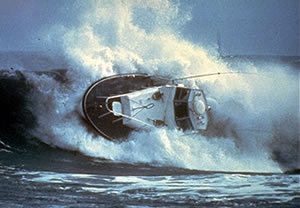 On November 13, 1969, CG-44300 was called to escort the Rustler, a Mexican tug, across the bar and into Yaquina Bay. The mission should have been a easy, but when the motor lifeboat reached the Rustler’s reported location, the tug was nowhere to be found. As CG-44300 searched up and down the coast, beach parties were sent out between Depoe Bay and Beaver Creek to help locate the Rustler. The Rustler was finally found several miles to the north, apparently in no immediate danger. With the storm worsening, the 44300 refueled and headed out to assist the Rustler. By this time, the sun had set. Shortly after crossing the bar, the 44300 was hit by a large wave and knocked parallel to the surf The next wave was 38 feet high and breaking. Hitting broadside, the wave forced the motor lifeboat to roll over. After a quick check of crew and engines, the 44300 headed out to safer water. Eight miles offshore, with the boat no longer in danger of being hit by another large breaking wave, the crew conducted a more thorough check This revealed that all the communication equipment, except the FM radio, was gone. The mast and the radar were broken, the anchors were gone, and almost everything else was bent, broken, torn loose, or stove in. Despite the damage, the 44300 was still operational. She was given a back up radio from a ship in the area and waited out the night. The next morning, the storm being over, the 44300 returned to Yaquina Bay. If it had been necessary, Chief Webb said, "the 44300 would have continued up north to aid her (the Rustler), even after receiving considerable damage."
On November 13, 1969, CG-44300 was called to escort the Rustler, a Mexican tug, across the bar and into Yaquina Bay. The mission should have been a easy, but when the motor lifeboat reached the Rustler’s reported location, the tug was nowhere to be found. As CG-44300 searched up and down the coast, beach parties were sent out between Depoe Bay and Beaver Creek to help locate the Rustler. The Rustler was finally found several miles to the north, apparently in no immediate danger. With the storm worsening, the 44300 refueled and headed out to assist the Rustler. By this time, the sun had set. Shortly after crossing the bar, the 44300 was hit by a large wave and knocked parallel to the surf The next wave was 38 feet high and breaking. Hitting broadside, the wave forced the motor lifeboat to roll over. After a quick check of crew and engines, the 44300 headed out to safer water. Eight miles offshore, with the boat no longer in danger of being hit by another large breaking wave, the crew conducted a more thorough check This revealed that all the communication equipment, except the FM radio, was gone. The mast and the radar were broken, the anchors were gone, and almost everything else was bent, broken, torn loose, or stove in. Despite the damage, the 44300 was still operational. She was given a back up radio from a ship in the area and waited out the night. The next morning, the storm being over, the 44300 returned to Yaquina Bay. If it had been necessary, Chief Webb said, "the 44300 would have continued up north to aid her (the Rustler), even after receiving considerable damage."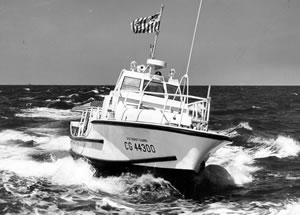 Her last mission was fitting of her career. On July 30, 1996, the 44300 was called to active duty so that the entire complement of Station Cape Disappointment could attend the Gold Lifesaving Medal award ceremony for a fellow crewmember. The 44300 was stationed on the bar for emergencies. (With the increased number of pleasure boats crossing the bar during salmon season, the rescue boats are positioned across the bar to shorten emergency response time.) She responded to a call from a 17-foot pleasure craft that was disabled and adrift. Just after arriving on the scene, 44300 lost her port engine. However, the crew was determined to make this mission a success, and towed the pleasure craft inbound before being relieved by another boat. This turned out to be her last mission.
Her last mission was fitting of her career. On July 30, 1996, the 44300 was called to active duty so that the entire complement of Station Cape Disappointment could attend the Gold Lifesaving Medal award ceremony for a fellow crewmember. The 44300 was stationed on the bar for emergencies. (With the increased number of pleasure boats crossing the bar during salmon season, the rescue boats are positioned across the bar to shorten emergency response time.) She responded to a call from a 17-foot pleasure craft that was disabled and adrift. Just after arriving on the scene, 44300 lost her port engine. However, the crew was determined to make this mission a success, and towed the pleasure craft inbound before being relieved by another boat. This turned out to be her last mission.